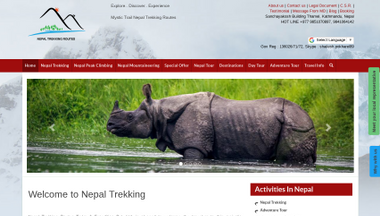 Is winter Himalayan mountaineering possible without Artur Hajzer? “Well, they say ‘in for a penny, in for a pound.’ There is a will to finish it, an urge to confirm the Polish leadership in this discipline. It is a wonderful idea and I am making it happen with passion,” he used to say. Although the Gasherbrum expedition, during which he died, took place outside of the Polish Winter Himalayan Mountaineering Project 2010-2015 (Polski Himalaizm Zimowy – PHZ), it had been well known that he went there to build up his stamina for the remaining summits which have not been climbed in winter yet. He was one of the youngest Ice Warriors and has become the eternally young Ice Leader. This article, written by Jagoda Mytych, was originally published in “n.p.m.” magazine in September 2013.
Is winter Himalayan mountaineering possible without Artur Hajzer? “Well, they say ‘in for a penny, in for a pound.’ There is a will to finish it, an urge to confirm the Polish leadership in this discipline. It is a wonderful idea and I am making it happen with passion,” he used to say. Although the Gasherbrum expedition, during which he died, took place outside of the Polish Winter Himalayan Mountaineering Project 2010-2015 (Polski Himalaizm Zimowy – PHZ), it had been well known that he went there to build up his stamina for the remaining summits which have not been climbed in winter yet. He was one of the youngest Ice Warriors and has become the eternally young Ice Leader. This article, written by Jagoda Mytych, was originally published in “n.p.m.” magazine in September 2013.

“Everyone knows one of his faces, one or a few,” wrote Izabela Hajzer about her husband and best friend. And in fact, you could really separate Artur Hajzer’s resume into a number of people. He was a top quality climber with seven eight-thousanders to his name, a successful businessman, the founding father and chief executive of a project which made the Poles start climbing eight-thousanders in winter again. Even if not all the goals he had set were accomplished successfully, he never gave up. He was well known for his endurance and perseverance as well as his wittiness and willingness to share his knowledge and experience.
Artur died on 07 July 2013 while retreating from Gasherbrum I, one of the two eight-thousanders he had planned to ascend this year to “keep fit and stay in touch with the altitude in case another winter expedition was about to take place in the coming years.” We bid him farewell on 24 July in the arch-cathedral in Katowice, the same church, in which 24 years earlier another service had been performed to commemorate Jerzy Kukuczka. Janusz Majer, not only Artur’s business partner for many years but also a friend, gave a moving speech during the funeral service.
While I was working on this text, he told me: “Everyone knows one of his faces. Just so. I think I knew them all. When you work together, there are many reasons to end friendship, but we made it. We went through a lot of twists and turns.”
Snow Elephant
Artur was born on 28 June 1962 in Silesia. He graduated from the University of Katowice with a degree in Cultural Studies but since he was a teenager, he had been active in the Silesian mountaineering circles where he had been nicknamed ‘Elephant’. When he was 14 years of age, he started climbing with the Tatra Scout Club. At the age of 16, he finished the climbing course in the Tatra mountains, so called ‘Betlejemka’. His sporty attitude could already be seen at that time. He climbed Kazalnica Mięguszowska via many routes, Ganek and other faces, and a few difficult routes in the Alps in the Mont Blanc massif, including Petit Dru and Mont Blanc du Tacul.

Mont Blanc 1981

Artur Hajzer’s later climbing career was closely linked to the Mountaineering Club in Katowice, which at that time was called “the best Himalayan mountaineering club in the world’, as it was the place where Jerzy Kukuczka, Krzystof Wielicki and Ryszard Pawłowski had actively been involved.
“We were one large family in the club. Our lives revolved around the club. We did not only spent time climbing rocks or mountaineering but worked together, partied together and went to concerts together. Artur was a significant individual in the club. He was one of the promising young who did not end up as ‘promising’ but actually achieved a lot by the age of 30,” recalls Janusz Majer, who had been the chairman of the club in Katowice since 1980 and is its honorary member at present.

Hajzer was not only an above-average climber but also a savvy and talented … tailor. He would sew everything for himself and his fellow climbers, from harnesses and backpacks to articles of clothing and down jackets. It was an invaluable experience, taking into account the fact that he was then one of the pioneers of the Polish outdoors industry. He was also familiar with painting – especially at high altitude.
Artur reminisced the summer of 1982 in his book Attack of Despair. “Every day was the same. We did not let the paint rollers out of our hands from dawn till dusk. Fortunately, we spent weekends climbing rocks in the Polish Jurassic Highland, mastering our climbing form. We did not know then which mountains we were about to be tested in.”
And the same year, at the age of 20, with a trip to Rolwaling Himal region, Artur began his Himalayan adventure. The following year, he took part in an expedition to Tirich Mir (7,706m), the highest mountain of the Hindu Kush range. In 1985, he made his first attempt on the south face of Lhotse. The club expedition had already been at Camp V, when it was joined by another member of the Katowice circles – Jerzy Kukuczka.

Artur Hajzer with Rafał Chołda, Kathmandu 1982
Regrettably, although Hajzer met his idol and future climbing partner, he lost his current partner, Rafał Chołda, who died climbing Lhotse. Artur wrote that “from the very first moment they tied and shared a rope, they walked the same path.” The expedition was unsuccessful. Almost immediately afterwards, he set out on another one – a winter expedition to climb Kangchenjunga. He reached the summit again and again faced death in the mountains. This time it was Andrzej Czok who lost his life.
Jerzy Kukuczka’s partner
When you look for a phrase to describe Artur Hajzer, one of the first that comes to mind is ‘Jurek Kukuczka’s partner.’ Even though their first expedition was not successful, after Lhotse Hajzer felt much more secure.

Artur Hajzer, Wanda Rutkiewicz and Jerzy Kukuczka, Annapurna 1987
“I started believing in myself. I realised that my first steps were analogous to what Jurek had been doing a few years back. Eventually, I felt convinced that the Lhotse failure had not determined it all and the next time – as proven by Jurek’s career – would be better,” Hajzer recalled years later. And it was better, together with Jerzy Kukuczka.
“How about going on an expedition with me? I need a partner. How about that?”
“I am all for it, on spec”, answered Elephant to Kukuś.
“It was very elevating to Artur, he was very pleased. Jurek Kukuczka offered Artur that if he had organised an expedition to Manaslu and a winter expedition to Annapurna, they would climb together. And so it happened, and that is the reason Artur decided not to go with us to climb K2 via the Magic Line route,” recalls Janusz Majer.
“The Manaslu (8,156m) expedition was the most difficult of all our – mine and Jurek’s – successful expeditions. It took place in autumn 1986. We were to attempt the south face of Annapurna (8,091m) in the same season,” wrote Hajzer. On 03 February 1987 they made their first winter ascent together to the summit of an eight-thousander.
Another expedition they went on together was a summer expedition to Shishapangma in August 1987, during which they established a new route on the western ridge. The same year, Artur made another attempt on the south face of Lhotse during an international expedition organised by Krzysztof Wielicki. The expedition was a failure. In 1988, he accompanied Jurek Kukuczka, this time ascending the west Annapurna via a new route. A year later he returned for the third time to the south face of Lhotse. That time, the international expedition was organised by the Kukuczka’s ‘greatest rival’ – Rainhold Messner.
“After that expedition I came to a conclusion that another attempt would be a waste of time,” Artur writes in Attack of Despair. That is why he did not join Kukuczka during his attempt.
“It was clear that Artur had equalled his master and his own ambition took the floor. He wanted to bring his own mountaineering projects to life,” recalls Janusz Majer.
On 24 October 1989, Jerzy Kukuczka fell of the south face of Lhotse and died. Artur Hajzer gave up climbing for a long time.
“It took me 15 years to get over it,” that is all he told me about that incident and switched off for a while. He looked as if he was not talking about something in the past but processing news that had just arrived. When he returned to Lhotse under the Polish Winter Himalayan Mountaineering Project, he said that it was ‘a conversation with ghosts.’
Rescuing and rescued
1989 was as equally tragic to Polish Himalayan mountaineering as 2013. In 1989, five eminent climbers died in an avalanche on Lho La pass while climbing Mount Everest: Eugeniusz Chrobak (expedition leader), Zygmunt Andrzej Heinrich, Mirosław ‘Falco’ Dąsal, Wacław Otręba and Mirosław Gardzielewski. The only survivor was Andrzej Marciniak, suffering from snow blindness while awaiting rescue. Hajzer was in Kathmandu at that time. With no hesitation he set about organising a complicated rescue mission from China, as it was the only possible way.
“At that time, people were protesting in Tiananmen Square. Borders were tightly shut. The American Embassy needed to exert pressure. To organise the rescue mission was probably more difficult than to pull it off. But I got instructed by Janusz Majer that either I would do something or it was done and dusted. In such moments, there is really no room to debate, or it is all over,” recalled Artur Hajzer.
“It seemed to me that Artur was the only person able to organise a rescue missions under those complicated circumstances. Even though there were excellent climbers in the base camp, it was impossible to approach from our side because of the avalanche danger. The only option left was unconventional. It was a challenge to Artur, the quintessence of his way of life. He started acting immediately. He was talking to Messner. Messner was talking to the Italian ambassador who was playing tennis with the Russian ambassador the following day. It was all about getting to the Chinese and get their permission for the mission,” said Janusz Majer.

Akcja ratunkowa po Andrzeja Marciniaka, 1989, z archi. A. Hajzera
For a daring rescue mission on Mount Everest Artur received the Polish Olympics Committee Fair Play Award. 20 years later, Andrzej Marciniak died while climbing in the Tatras. When Hazjer was asked about it, he emphasised that the most important aspect of it was that he had managed to give him those extra 20 years.
Not only did Hajzer recue people but was also rescued by them. In 2005, on Broad Peak, he broke his leg at almost 8,000m. Piotr Pustelnik, who was climbing with him then, led the rescue mission. In February 2008, he was taken by an avalanche on the south ridge of Ciemniak in the west Tatras. He managed to stay close to the surface and thanks to a well-organized TOPR mission, he was rescued unscathed and even got a reputation of ‘always landing on his feet.’ For walking outside of the designated tourist route, the Tatra National Park board of directors gave him a symbolic disciplinary warning.

Hajzer rescued by TOPR from avalanche, Ciemniak, 2008.
“February 2008, the Tatras. Objective: to traverse the entire Tatra ridge non-stop. I am walking with three experienced Himalayan mountaineers. I feel safe. We are in our twenty second hour of walking, we are ascending Ciemniak. Artur is first and suddenly disappears. Panic stations – Piotrek is trying to get reception and notify TOPR. Darek is going downhill. Done, TOPR is notified, they are coming. Hearing the helicopter, we walk slowly down in silence. Minutes are passing. And then I got a text message from Artur: I am alive. My first thought: Artur, you are invincible. That thought is with me today as well,” recalls Tamara Styś, a Himalayan mountaineer.
Businessman
After 1989, he withdrew from active climbing and together with Janusz Majer took to business, which gave birth to a brand that became cult in the 90s – Alpinus.
“After Everest, Artur came up with this idea of 14 eight-thousanders in a year. We were supposed to have one million dollars to do it. We were sorting out permissions. The entire organisation process was well advanced. We even had business cards. In autumn 1989, when Jurek was on Lhotse, Artur and I went to lSPO to look for a sponsor for our project. We talked to a number of people, including Albrecht von Dewitz, the founder of Vaude, a huge German outdoor brand. Eventually, we did not get a sponsor for our Himalayan project but a business partner,” says Janusz Majer. “First, we sewed for Vaude and then directly for Alpinus. From Vaude we got the know-how. Our advantage was that we knew the product inside out. Our products were known to be of good quality. Even today I meet people wearing our jackets made in the 90s,” he adds.
High quality materials, advanced technologies and, at the same time, limited interest of the Polish people in the outdoor market resulted in financial difficulties of the company, leading to its bankruptcy. The founders were not put off, though. Hajzer and Majer’s new project was another brand which was more affordable to the customer. HiMountain products are visible almost everywhere in the Polish mountains.
“We had already had experience gained during the liquidation of our first enterprise, so when we were creating HiMountain, we were trying to eliminate the root causes of our previous failure. But we had never given up on quality. Artur was very creative at work and kept following all current market trends. He knew how to build a team and come up with new projects which would attract people to participate in their implementation,” says Janusz Majer.
After 15 years in business, Artur realised that ‘he could not live peacefully without mountains.‘ He returned to climbing in 2005. First, almost instantly, he went to climb Broad Peak with Piotr Pustelnik and then Dhaulagiri with Robert Szymczak.
Winter expeditions leader
Artur’s business approach can be traced in the way the Polish Winter Himalayan Mountaineering Project 2010-2015 functions, which, according to Artur Hajzer, has been born out of a need to convince PZA to fund expeditions in the highest mountains.
“The fact that the project exists depends 90% on office and managerial work and one day I should really write what it looks like from behind the desk,” Artur used to joke.
And it looked like this. On 14 November 2009, 3 potential Himalayan mountaineers showed up in his office: Arek Grządziel, Jacek Czech and Irek Waluga. The next day was the deadline for funding applications.
“We knew PZA would not give a penny for a regular route climb, even in winter, if the success were not guaranteed. Robert Szymczak and I had just been refused financial support for a winter Broad Peak expedition 2008/2009. It was then when I came up with this idea that I would draft a project which would not be about climbing via regular routes but winter expeditions in the years to come,” recalled Hajzer.
The seed took root and in May 2010, already under the Polish Winter Himalayan Mountaineering Project 2010-2015, an expedition was organised to climb Nanga Parbat. Artur reached the summit with Robert Szymczak and during the second attack, Marcin Kaczan, one of the younger members of the team, ascended to the summit. ‘The young’ proved themselves again during the Elbrus Race. Andrzej Bargiel and Ola Dzik finished the race in record time. Continue reading →
Filed under: Anna Czerwinska, Artur Hajzer, Climbers, Expedition, himalaisci/ -tki, Himalayas, Ice Climbing, Jerzy Kukuczka, Nepal, Piotr Pustelnik, Polish Himalayas, Ryszard Pawłowski, Tibet, trekking, winter expedition, wyprawy | 2 Comments »

 Mount Everest od południowego zachodu (fot. Krzysztof Wielicki)
Mount Everest od południowego zachodu (fot. Krzysztof Wielicki)










































